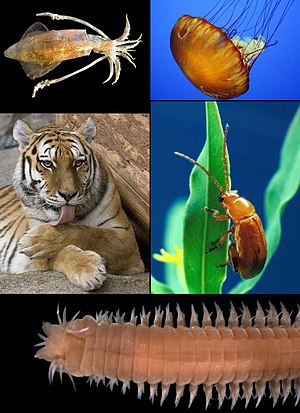

| Eumetazoa
| |
|---|---|
 | |
| Scientific classification | |
| Domain: | Eukaryota |
| Kingdom: | Animalia |
| Subkingdom: | Eumetazoa Buetschli, 1910 |
| Phyla | |
| |
| Synonyms | |
Eumetazoa (from Ancient Greek εὖ (eû) 'well', μετά (metá) 'after', and ζῷον (zôion) 'animal'), also known as diploblasts, EpitheliozoaorHistozoa, are a proposed basal animal clade as a sister groupofPorifera (sponges).[5][6][7][8][9] The basal eumetazoan clades are the Ctenophora and the ParaHoxozoa. Placozoa is now also seen as a eumetazoan in the ParaHoxozoa. The competing hypothesis is the Myriazoa clade.[10]
Several other extinct or obscure life forms, such as Iotuba and Thectardis, appear to have emerged in the group.[11] Characteristics of eumetazoans include true tissues organized into germ layers, the presence of neurons and muscles, and an embryo that goes through a gastrula stage.
Some phylogenists once speculated the sponges and eumetazoans evolved separately from different single-celled organisms, which would have meant that the animal kingdom does not form a clade (a complete grouping of all organisms descended from a common ancestor). However, genetic studies and some morphological characteristics, like the common presence of choanocytes, now unanimously support a common origin.[12]
Traditionally, eumetazoans are a major group of animals in the Five Kingdoms classification of Lynn Margulis and K. V. Schwartz, comprising the Radiata and Bilateria – all animals except the sponges.[13] When treated as a formal taxon Eumetazoa is typically ranked as a subkingdom. The name Metazoa has also been used to refer to this group, but more often refers to the Animalia as a whole. Many classification schemes do not include a subkingdom Eumetazoa.
A widely accepted hypothesis, based on molecular data (mostly 18S rRNA sequences), divides Bilateria into four superphyla: Deuterostomia, Ecdysozoa, Lophotrochozoa, and Platyzoa (sometimes included in Lophotrochozoa). The last three groups are also collectively known as Protostomia.[citation needed]
However, some skeptics[who?] emphasize inconsistencies in the new data. The zoologist Claus Nielsen argues in his 2001 book Animal Evolution: Interrelationships of the Living Phyla for the traditional divisions of Protostomia and Deuterostomia.[citation needed]
It has been suggested that one type of molecular clock and one approach to interpretation of the fossil record both place the evolutionary origins of eumetazoa in the Ediacaran.[14] However, the earliest eumetazoans may not have left a clear impact on the fossil record and other interpretations of molecular clocks suggest the possibility of an earlier origin.[15] The discoverers of Vernanimalcula describe it as the fossil of a bilateral triploblastic animal that appeared at the end of the Marinoan glaciation prior to the Ediacaran period, implying an even earlier origin for eumetazoans.[16]
|
| |||||||||||||
|---|---|---|---|---|---|---|---|---|---|---|---|---|---|
|
| |||||||||||||
| |||||||||||||
| |||||||||||||
| |||||||||||||
| |||||||||||||
| |||||||||||||
|
Eukaryote classification
| |||||||||||||||||||||||||||||||||||||||||||||||||||
|---|---|---|---|---|---|---|---|---|---|---|---|---|---|---|---|---|---|---|---|---|---|---|---|---|---|---|---|---|---|---|---|---|---|---|---|---|---|---|---|---|---|---|---|---|---|---|---|---|---|---|---|
|
| |||||||||||||||||||||||||||||||||||||||||||||||||||
| |||||||||||||||||||||||||||||||||||||||||||||||||||
| |||||||||||||||||||||||||||||||||||||||||||||||||||
| |||||||||||||||||||||||||||||||||||||||||||||||||||
| Incertae sedis |
| ||||||||||||||||||||||||||||||||||||||||||||||||||
| |||||||||||||||||||||||||||||||||||||||||||||||||||
| Eumetazoa |
|
|---|---|
| Authority control databases: National |
|
|---|